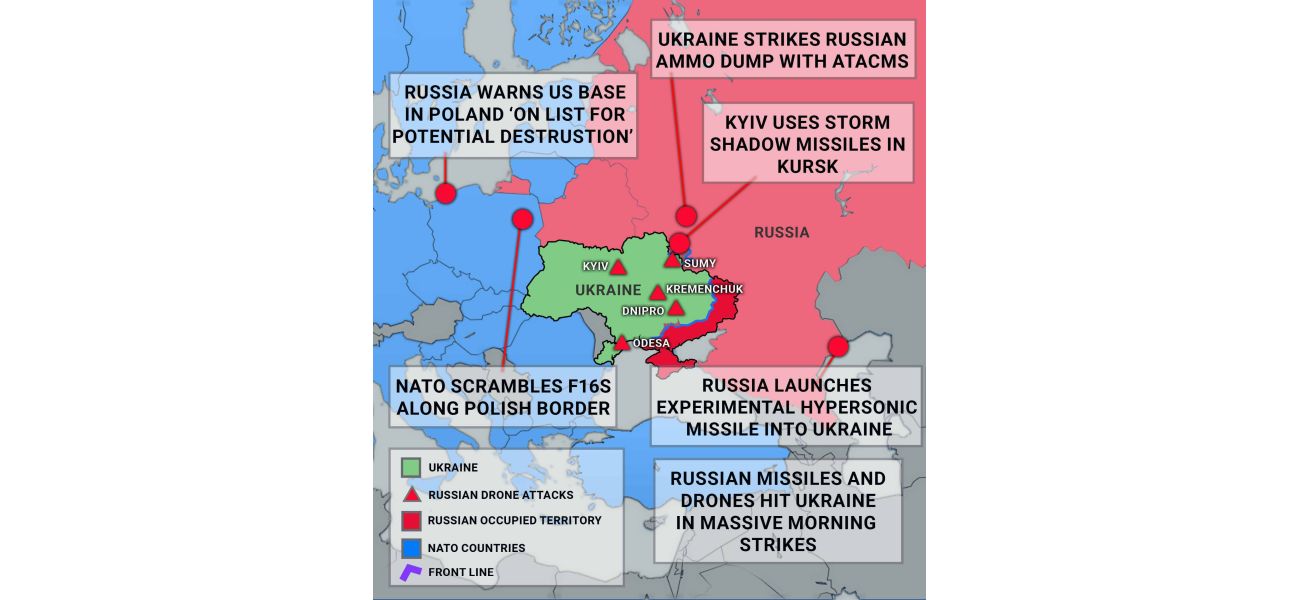A remarkable sight as Putin's hypersonic missile cuts through the air during the attack on Ukraine.
Initial concerns that this was the first intercontinental missile launched during war have been ruled out.
November 21st 2024.

The tension between Russia and Ukraine has escalated even further as Russian President Vladimir Putin launched a new hypersonic ballistic missile at the neighboring country. The missile, called Oreshnik, was fired from the southern Astrakhan region and targeted the city of Dnipro in retaliation for Ukraine's use of US and British weapons to strike Russian military targets.
The attack, which occurred at around 5am local time, was captured on footage circulating on social media. It caused damage to several buildings and left 15 people injured, including two teenagers who were taken to the hospital. Initially, there were fears that the missile could be an intercontinental ballistic missile (ICBM), a long-range weapon capable of carrying nuclear warheads. This raised concerns about Russia's nuclear capabilities, especially after Putin signed a revised nuclear doctrine just two days prior, lowering the threshold for the use of nuclear weapons.
However, Putin later clarified that the missile used was a medium-range Oreshnik missile, which is still experimental but not as powerful as an ICBM. He claimed that it was aimed at a Ukrainian military facility in Dnipro, in response to Ukraine's use of US and British missiles to strike critical infrastructure in Russia. This marks a dangerous escalation in the conflict between the two countries, which has been ongoing since 2022 when Russia invaded Ukraine.
The use of long-range missiles and drones provided by Iran and North Korea in this attack further demonstrates the global nature of this conflict. In recent weeks, thousands of North Korean troops have gathered along Russia's border with Ukraine, with some already engaging in battle. This has added another dimension to the already complex situation.
But what exactly is the difference between an ICBM and a mid-range missile? According to the Centre for Arms Control and Non-proliferation, there are four classes of ballistic missiles based on their range. Short-range missiles have a range of less than 620 miles, medium-range between 620 miles and 1,860 miles, intermediate-range between 1,860 miles and 3,410 miles, and long-range with a minimum of 3,410 miles. An ICBM falls under the long-range category and can travel more than 5,000 miles, making it capable of reaching cities in the US.
Initially, Ukraine's air force claimed that Russia had fired an ICBM along with eight other missiles, but there was no evidence of nuclear warheads being used. This could have led to a much bigger reaction from Ukraine and its Western allies. The fact that the missile was not an ICBM was confirmed by Pavel Podvig, director of the Russian Nuclear Forces Project. He also pointed out that using these types of missiles for conventional purposes does not make much sense due to their low accuracy and high cost.
Former Russian diplomat Vladimir Frolov also cast doubt on the claim that an ICBM was used in this attack, stating that Russia would have to notify the US and China before any launch. Richard Gardiner, an analyst in corporate intelligence, predicted a response from the Kremlin after the US and UK authorized the use of their missiles against Russian targets.
The use of an ICBM, if confirmed, would have been a significant escalation in the conflict. However, analysis of the wreckage in Dnipro will determine the exact weapon used, and it is likely to be a mid-range missile. This attack serves as a strong message from Russia to the West that the conflict in Ukraine has global implications. As the situation continues to escalate, it is important to stay updated on the latest developments through reliable sources like The Agency.
The attack, which occurred at around 5am local time, was captured on footage circulating on social media. It caused damage to several buildings and left 15 people injured, including two teenagers who were taken to the hospital. Initially, there were fears that the missile could be an intercontinental ballistic missile (ICBM), a long-range weapon capable of carrying nuclear warheads. This raised concerns about Russia's nuclear capabilities, especially after Putin signed a revised nuclear doctrine just two days prior, lowering the threshold for the use of nuclear weapons.
However, Putin later clarified that the missile used was a medium-range Oreshnik missile, which is still experimental but not as powerful as an ICBM. He claimed that it was aimed at a Ukrainian military facility in Dnipro, in response to Ukraine's use of US and British missiles to strike critical infrastructure in Russia. This marks a dangerous escalation in the conflict between the two countries, which has been ongoing since 2022 when Russia invaded Ukraine.
The use of long-range missiles and drones provided by Iran and North Korea in this attack further demonstrates the global nature of this conflict. In recent weeks, thousands of North Korean troops have gathered along Russia's border with Ukraine, with some already engaging in battle. This has added another dimension to the already complex situation.
But what exactly is the difference between an ICBM and a mid-range missile? According to the Centre for Arms Control and Non-proliferation, there are four classes of ballistic missiles based on their range. Short-range missiles have a range of less than 620 miles, medium-range between 620 miles and 1,860 miles, intermediate-range between 1,860 miles and 3,410 miles, and long-range with a minimum of 3,410 miles. An ICBM falls under the long-range category and can travel more than 5,000 miles, making it capable of reaching cities in the US.
Initially, Ukraine's air force claimed that Russia had fired an ICBM along with eight other missiles, but there was no evidence of nuclear warheads being used. This could have led to a much bigger reaction from Ukraine and its Western allies. The fact that the missile was not an ICBM was confirmed by Pavel Podvig, director of the Russian Nuclear Forces Project. He also pointed out that using these types of missiles for conventional purposes does not make much sense due to their low accuracy and high cost.
Former Russian diplomat Vladimir Frolov also cast doubt on the claim that an ICBM was used in this attack, stating that Russia would have to notify the US and China before any launch. Richard Gardiner, an analyst in corporate intelligence, predicted a response from the Kremlin after the US and UK authorized the use of their missiles against Russian targets.
The use of an ICBM, if confirmed, would have been a significant escalation in the conflict. However, analysis of the wreckage in Dnipro will determine the exact weapon used, and it is likely to be a mid-range missile. This attack serves as a strong message from Russia to the West that the conflict in Ukraine has global implications. As the situation continues to escalate, it is important to stay updated on the latest developments through reliable sources like The Agency.
[This article has been trending online recently and has been generated with AI. Your feed is customized.]
[Generative AI is experimental.]
0
0
Submit Comment





